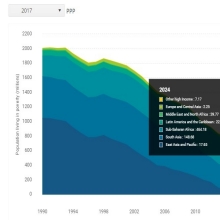Addressing structural inequality represents one of the continent’s best opportunities to accelerate poverty reduction, increase productivity and earnings, and ensure fairness. Tackling structural inequality requires confronting its many root causes, which include inadequate and inequitable public investments, market failures, as well as different levels of exposure to risks such as conflict and climate change.
Africa is the world’s second most unequal region after Latin America. Over half of African countries have a Gini index above 40, a statistical measure indicating high levels of inequality. The evidence suggests that the sources of this inequality are structural, as they result from inherited or unalterable characteristic (such as where people are born, their parents’ education, ethnicity, religion, or gender) or derive from the way markets and institutions are structured (for example when only some firms, farms, and workers have access to markets, employment, and opportunities, at the detriment of others).
Poverty reduction in Africa has stalled since the mid-2010s. While the incidence of extreme poverty dropped to single digits worldwide, the pace of poverty reduction in Africa slowed down and flatlined during the past decade. As of 2022, Africa’s extreme poverty rate stands at 38%, the highest of all regions, with the region housing over 60% of the global extreme poor population. Tackling high poverty is complicated by the region’s high vulnerability to shocks.
Economic growth has been low and volatile, with limited impact on poverty reduction. Since 2014, growth has barely kept pace with population growth. Moreover, economic growth has been less efficient in reducing poverty in Africa: growth of 1% in per capita GDP is associated with only a 1% reduction in the poverty rate in Africa, compared to a 2.2% reduction in the rest of the world. This lower level of efficiency is closely tied to the region’s high inequality.
This is the region’s moment to embrace change. With millions of young Africans entering the labor market each year, countries in the region will need to make a concerted effort to expand opportunities and support job creation.






